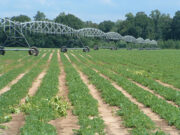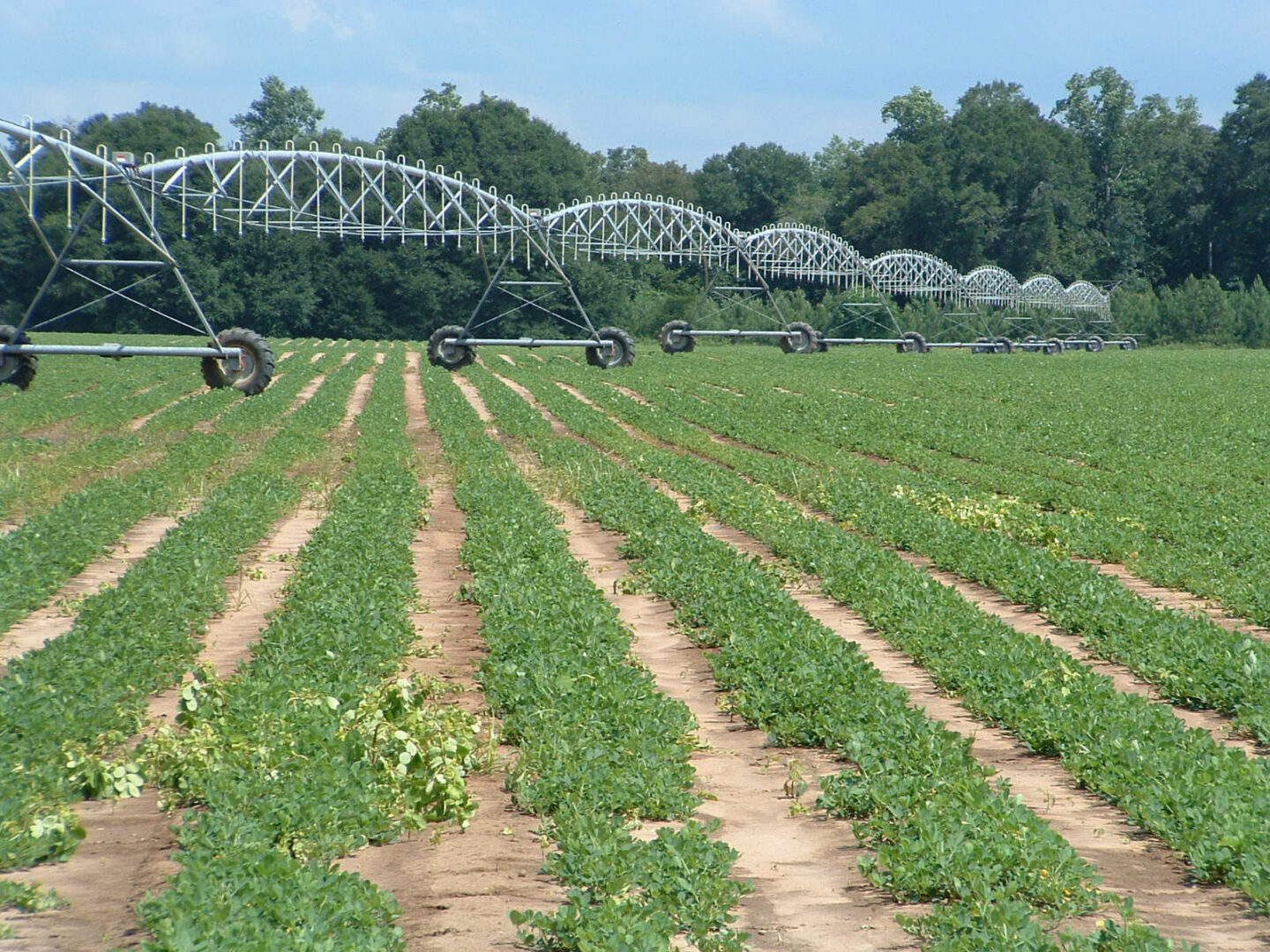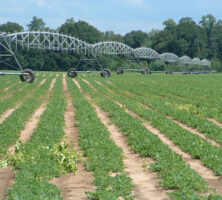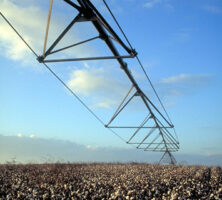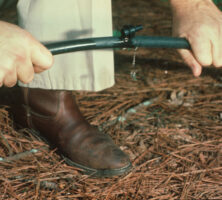More than 1.5 million acres of orchards and fields are irrigated in Georgia, and a cornucopia of vegetable, fruit, nut, fiber, and animal feed crops are made possible by the surface runoff and groundwater stores that are replenished by Georgia’s generous rainfall. A close look at the workings of the two most prevalent types of irrigation reveals how critical these processes are to sustaining Georgia’s agricultural economy.
Center-Pivot Irrigation
With its humming, grinding noise muffled by the thirty feet of water overhead, a well’s submersible pump draws in clear, cool water seeping from cracks and fissures in the surrounding rock and pushes it 150 feet up past the thumb-sized wires supplying power to the pump. After two 90-degree turns at the surface, 1,000 gallons per minute run through a slip joint that allows a stationary well to feed water to a moving pipe. One more turn, and water rushes down an eight-inch diameter pipe that stretches for a quarter mile.
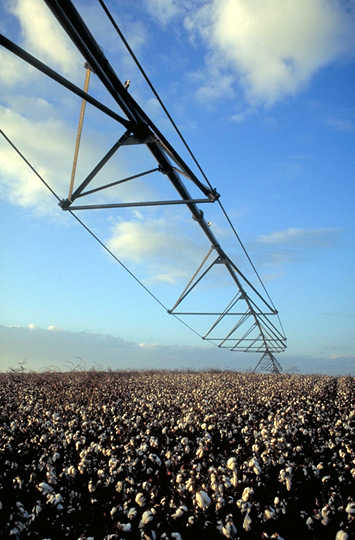
Courtesy of Georgia Department of Economic Development.
At each joint, set 155 feet apart, a small steel triangular tower holds the pipe aloft. Two tractor-like tires at the base of each tower are driven by a small motor between them. At the end of the pipe, the last tower, known as the boss tower, moves in its regular rhythm: forward one minute, stop; forward one minute, stop. Each of the towers in between the boss tower and the well adjusts in turn, following the boss tower’s lead. Their role is to keep the pipe in a straight line. All along the pipe carefully spaced openings lead water down drop tubes to sprinkler heads, which create a spray that trickles into the soil, replenishing the root zone with an inch of water.
For the next two and a half days the boss tower will travel over six miles as it traverses the circumference of a 125-acre field of peanuts. By the time it has finished, every portion of the field will have received a uniform helping of water to sustain plant growth for a few more days. As the farmer shuts down the system, he hopes that next week will bring some of Georgia’s annual forty to fifty inches of rainfall instead.
Nearly 10,000 of these center-pivot irrigation systems cover 1 million acres of productive farmland in south Georgia. Almost half of those farms lie in the fertile Dougherty Plain at the base of the Flint River. Tapping the deep, pure waters of the Upper Floridan aquifer, their wells pump not only water but also dollars into the region. The additional growth of high-quality peanuts, sweet corn, cotton, and animal feeds, made possible as these irrigation systems fill in rainfall gaps, means dollars for the local economy. Almost $25,000 more was produced on the peanut field described above as a result of irrigation. Those additional dollars enabled the farmer to pay bankers, fertilizer dealers, coworkers, downtown merchants, and tax commissioners.
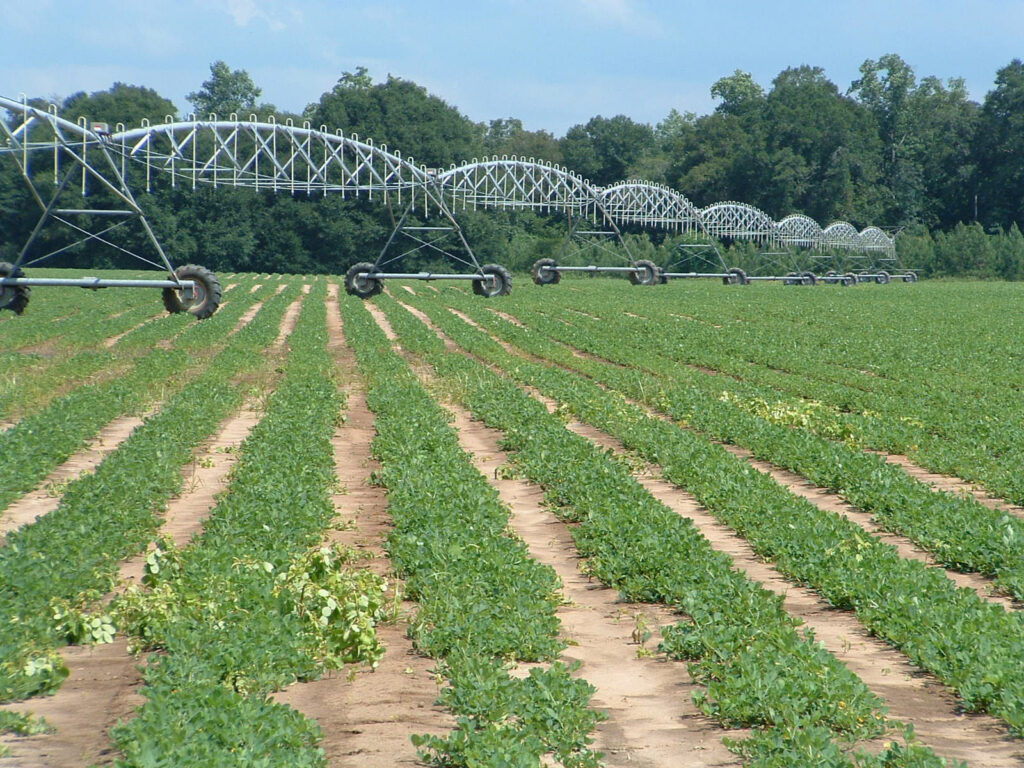
Courtesy of Matthew M. Moye
Drip Irrigation
Nearby, in a field of tomatoes, no superstructure of wheels and pipe can be seen. Growing out of holes in a plastic sheet covering the soil, each tomato plant is carefully staked and tied. The plastic cover and staking help to assure that nicely shaped, blemish-free tomatoes, which will be hand picked and boxed as vine ripe, will reach the stores. Beneath the plastic and under a few inches of soil, a one-inch-wide flat tube snakes for 500 feet. Every foot along the way, a tiny hole at the end of a remarkably well-engineered flow path built into the plastic wall emits a precise steady drip. After an hour, two quarts of water have been added right into the root zone of each tomato.
Three times each day, that drip will replace the water that sun and wind and heat pull from the tomato plants. Precisely controlled valves will open flow to the drip tapes and control the pressure of water flowing into each of hundreds of tapes. In response, a well located 100 feet below the ground pumps water through filters to remove any tiny grains of sand that could clog the tubes. As with center-pivot irrigation, the drip process provides not only water but also dollars. A 125-acre field of drip-irrigated tomatoes will pump $1.5 million into the local economy annually if conditions are right at harvest time. Drip irrigation, one of the fastest-growing methods of irrigation for high-value crops and orchards, is used on about 73,000 acres in Georgia. Because the water is placed directly at the roots, little is wasted in application.
Landscape Irrigation
Farmers are not the only ones who benefit from the state’s supplies of water. Growth in Georgia’s largest cities brings a new dimension to irrigation as the population explosion fuels the development of new residential areas, which are created from farm and forest lands. As prosperity grows, homeowners and businesses seek to beautify their surroundings with park-like plantings and large lawns. They also look for recreation at ever-increasing numbers of golf courses and athletic fields. To facilitate the lush growth of lawns, shrubs, trees, and other plants, urban dwellers turn to irrigation and water features in their landscapes.
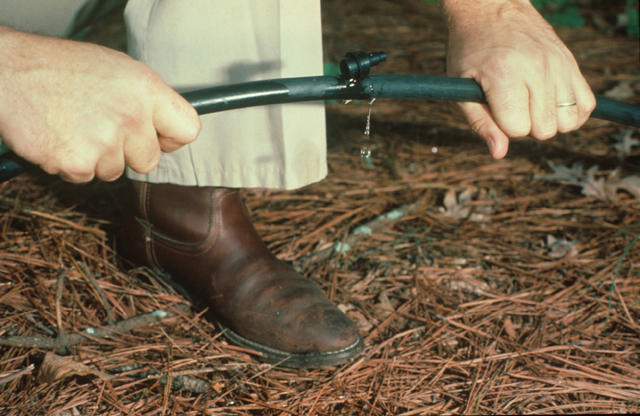
Photograph by Gary L. Wade
A green industry has developed to meet this new demand and to establish and protect urban landscapes with a dependable water supply through irrigation. Municipal suppliers of water have responded by increasing infrastructure and impoundments to accommodate the surge of water needed for irrigation during the summer, when water usage typically increases by an extra 50 percent. Though periods of drought have often required that some types of irrigation be curbed, such new methods as Xeriscape gardening, which relies on efficient irrigation practices to conserve water, allow urban dwellers to maintain their landscapes. Irrigation systems will remain a key ingredient in our economy as we gather and distribute water to supplement the state’s abundant rainfall.


